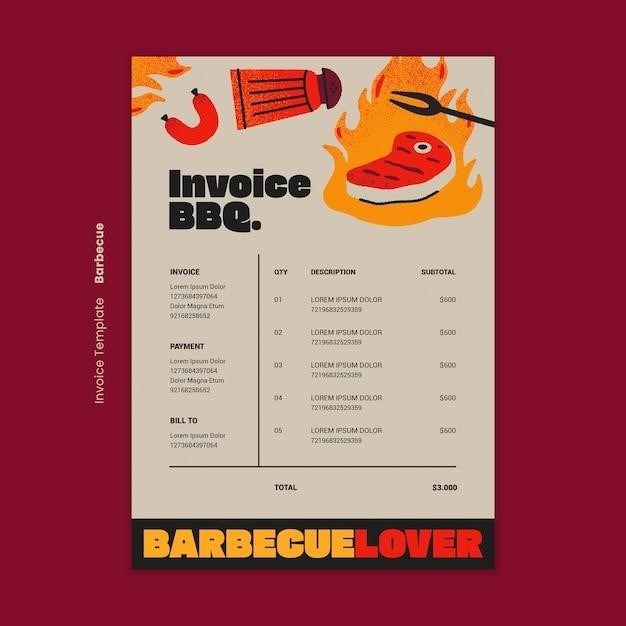
instruction book for george foreman grill
George Foreman Grill⁚ A Comprehensive Guide
This guide provides a comprehensive overview of using your George Foreman grill. From initial setup and preheating to cooking times‚ cleaning‚ troubleshooting‚ and accessing customer support‚ we’ve got you covered. Find answers to your questions and unlock delicious grilling potential. Explore recipes and tips for achieving perfect results every time.

Finding Your User Manual
Locating your George Foreman grill’s instruction manual is crucial for safe and effective operation. Several resources are available to help you find this important document. First‚ check the original packaging your grill came in; the manual is often included there. If you can’t find it in the box‚ search your home for the manual. It might be tucked away in a drawer or cupboard where you store appliance manuals.
If a physical copy is unavailable‚ the official George Foreman website (GEORGE FOREMAN.com) is an excellent resource. Their website features a comprehensive directory of user manuals for all their products‚ including grills. Simply navigate to their support or downloads section‚ enter your grill’s model number (often found on a label on the grill itself)‚ and download a digital copy of your manual. Alternatively‚ you can use online search engines like Google or Bing. Search for “[your grill model number] user manual” to find various online sources that might offer the manual as a PDF download. Remember to always download manuals from reputable sources to avoid malware.
Safety Precautions and Important Guidelines
Prior to using your George Foreman grill‚ carefully review the safety precautions outlined in your user manual. Never operate the grill without proper adult supervision. Always ensure the grill is placed on a stable‚ heat-resistant surface away from flammable materials like curtains or paper towels. Avoid touching hot surfaces directly; use oven mitts or pot holders to handle the grill and its components. Never immerse the grill or its electrical components in water or any other liquid for cleaning; this poses a serious risk of electric shock.
Before each use‚ inspect the grill’s power cord for any damage. Do not use the grill if the cord is frayed or damaged in any way. Unplug the grill from the power outlet when not in use and before cleaning. Always allow the grill to cool completely before attempting any cleaning or maintenance. Never leave the grill unattended while in operation. Keep children and pets away from the hot grill during and after use. If you experience any unusual smells‚ sounds‚ or malfunctions‚ immediately unplug the grill and contact customer support. Adhering to these safety guidelines will ensure safe and enjoyable grilling;
Preheating and Initial Setup
Setting up your George Foreman grill is straightforward. Begin by carefully unpacking the grill and its components‚ ensuring all parts are present and undamaged. Refer to your user manual for a detailed parts list and diagram; Locate a stable‚ level surface‚ away from flammable materials‚ to position your grill. Ensure the power cord is undamaged before plugging it into a suitable electrical outlet.
Before cooking‚ preheating your George Foreman grill is crucial for optimal results. Most models do not have explicit temperature settings; however‚ a brief preheating period is recommended. Lightly wipe the grill plates with cooking oil or butter (avoid low-fat spreads‚ as they may burn). Close the lid and let the grill heat up for approximately 5 minutes. This allows the plates to reach the ideal temperature for even cooking. The preheating process ensures that your food cooks thoroughly and develops a nice sear‚ resulting in delicious and evenly cooked meals. For models with temperature controls‚ set to the highest setting during preheating.
Cooking Times and Temperature Settings
Cooking times on a George Foreman grill vary depending on the food’s thickness and desired doneness. While many basic models lack precise temperature controls‚ operating at the highest setting generally provides optimal results. Thicker cuts of meat naturally require longer cooking times. Consult your instruction manual for specific recommendations for various foods‚ but here’s a general guideline⁚ Boneless chicken breast (½ inch thick) takes approximately 2-3 minutes per ½ inch of thickness. Fish steaks (½ to 1 inch thick) typically require 5-8 minutes. Hamburgers (¼ to ½ inch thick) usually need 5-8 minutes.
For more advanced models with adjustable temperature settings‚ experiment to find your preferred cooking temperature. Lower settings may be suitable for delicate foods or to prevent burning‚ while higher settings are ideal for achieving a crispier exterior. Always use a food thermometer to ensure food reaches a safe internal temperature. Remember that contact grilling‚ where both plates press against the food‚ significantly speeds up the cooking process compared to traditional grilling. Always monitor your food closely and adjust cooking time as needed to achieve your desired level of doneness. Overcooking can lead to dry‚ tough results.
Cleaning and Maintenance
Cleaning your George Foreman grill is crucial for maintaining its performance and extending its lifespan; Always unplug the grill and allow it to cool completely before attempting any cleaning. Never immerse the grill’s electrical components in water. For most models‚ wiping down the cooking plates with a damp cloth or sponge is sufficient for light cleaning. Stubborn food residues can often be removed with a non-abrasive cleaning pad and mild dish soap. Avoid using harsh chemicals or abrasive cleaners‚ as these can damage the non-stick surface.

After cleaning‚ ensure the grill is thoroughly dry before storing. Regularly check the grill’s exterior for any signs of damage or wear and tear. Inspect the power cord for any fraying or damage‚ and replace it immediately if necessary. For more thorough cleaning‚ some models allow for the removal of the cooking plates‚ making cleaning easier. Always refer to your specific model’s instruction manual for detailed cleaning instructions and recommendations. Proper care and maintenance will keep your George Foreman grill in top condition‚ allowing you to enjoy delicious‚ healthy meals for years to come. Remember‚ preventative maintenance will save you time and effort in the long run.
Troubleshooting Common Issues
Encountering problems with your George Foreman grill? Let’s address some common issues. If your grill isn’t heating up‚ first check the power cord to ensure it’s securely plugged in and that the outlet is functioning correctly. Examine the power switch to confirm it’s in the “on” position. If the grill is still not heating‚ there might be a problem with the internal heating element; consult your user manual or contact customer support. Food sticking to the cooking plates is a common issue‚ often solved by ensuring the plates are properly oiled or greased before grilling. Using low-fat cooking sprays can sometimes lead to sticking; try a small amount of oil instead.
Uneven cooking can result from improperly aligned cooking plates. Consult your manual for instructions on proper plate alignment. If the grill emits smoke or unusual odors‚ ensure that food isn’t burning due to excessive cooking time or insufficient greasing. Check for any food debris that may be causing the smoke. If the problem persists‚ contact customer support. Addressing these common issues promptly can help prevent further damage and maintain your George Foreman grill’s optimal performance. Remember to always refer to your user manual for specific troubleshooting advice tailored to your model.
Recipes and Cooking Tips
Unlock the culinary potential of your George Foreman grill with these tips and recipes! For perfectly cooked burgers‚ form patties of even thickness to ensure uniform grilling. Season generously and preheat your grill for optimal results. Cooking times will vary depending on thickness; thinner patties require less time. Experiment with different toppings and sauces to create your signature burger. For juicy chicken breasts‚ marinate them beforehand for enhanced flavor and tenderness. Aim for a thickness of about 1 inch for even cooking. Grilling time will depend on thickness and desired doneness; check frequently using a meat thermometer for safe internal temperatures.
Grilled fish fillets are a healthy and delicious option. Use firm‚ white-fleshed fish for best results. Season lightly with herbs and spices before grilling. For even cooking‚ ensure the fillet is of uniform thickness. Watch carefully to avoid overcooking‚ as fish cooks quickly. Serve immediately with your favorite sides. Don’t forget the importance of preheating your George Foreman grill for superior results! Experiment with various vegetables like bell peppers‚ zucchini‚ and onions for a flavorful side dish. Simply slice them into similar thicknesses and grill until tender-crisp. Remember to lightly oil the grill plates to prevent sticking.
Customer Support and Warranty Information
Should you encounter any issues with your George Foreman grill‚ accessing reliable customer support is crucial. The official George Foreman website (GEORGE FOREMAN.com) is an excellent starting point. There‚ you’ll likely find a comprehensive FAQ section addressing common problems and troubleshooting tips. You might also discover contact information for customer service representatives who can assist with more complex issues. Don’t hesitate to utilize their online resources‚ as they often provide detailed instructions and solutions. If you prefer a direct approach‚ look for a toll-free customer service number within your grill’s instruction manual or on the website. Preparedness is key; before contacting support‚ gather the necessary information‚ such as your grill’s model number and the nature of the problem. This will streamline the process and facilitate a quicker resolution.
Understanding your warranty is equally important. Your grill likely comes with a manufacturer’s warranty covering defects in materials and workmanship. The duration of this warranty and its specific terms will be detailed in the accompanying documentation. Carefully review the warranty information to understand its scope and limitations. This knowledge will prove invaluable if you need to make a claim for repair or replacement under warranty. Keep your purchase receipt and any other relevant documentation related to your grill‚ as this will help to validate your warranty claim should the need arise. Remember‚ proactive maintenance‚ as outlined in the user manual‚ can help prevent issues and maximize the lifespan of your appliance.